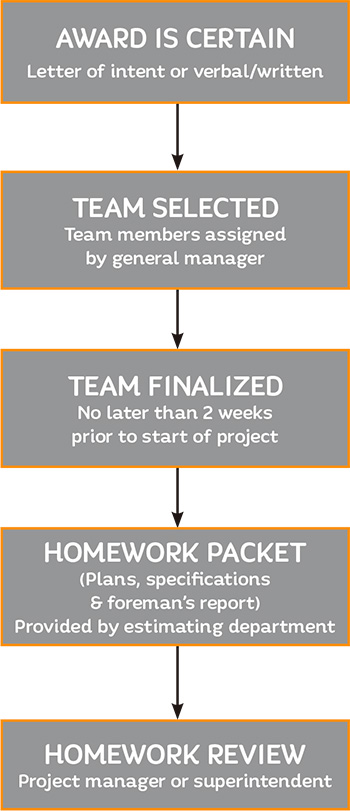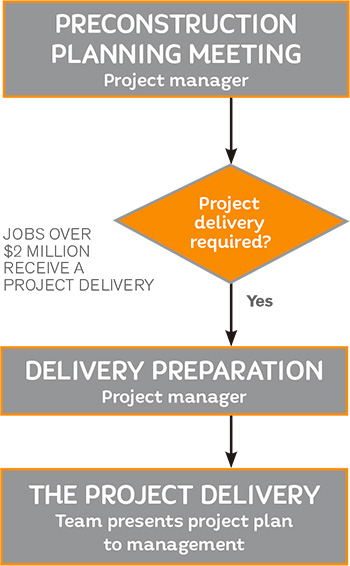
Consider your favorite football team. The announcer blares the starting lineup to the roar of raving fans. Focus the camera at the mouth of the tunnel and watch the interaction between the head coach and the quarterback. Wait, is the head coach going over plays with the quarterback just moments before he takes the field? That's probably a far-fetched scenario in the world of professional and collegiate sports. However, it is more than likely the reality for construction firms right before the start of any project. Organizations have long used the terms "handoff" and "turnover" to describe preconstruction planning. It is important to note that this is not true planning. Of course, it is essential for teams to conduct an appropriate transfer of information from the "get work team" to the "do work team." However, for so many firms, the planning process ends at this handoff. For other firms, manuals or "job books" are prepared and ceremoniously deposited on the manager's desk or superintendent's mailbox for review and assimilation. If your planning resembles more of a dictation than a true collaboration, you are not doing it correctly.

The Homework HandOff
It is also important to note that firms have to have a transfer. There is nothing wrong with this step in the process. However, you wouldn't hand a three-ring binder with the complete playbook to Tom Brady or Peyton Manning just minutes before kickoff. The first step in the process should be one that includes "homework and review" by the respective members of the project team. Below is an illustration of how this process should look.
Whether it is 2 weeks or 1 day, there has to be time for review. At that point, the real preconstruction meeting should be held. Now consider the dialogue that is had as a result of doing this homework. Rather than a perfunctory "check the box" exercise, the team should have a constructive conversation on how the project should be built.
Mandatory Quarterback
Often, preconstruction planning is done with only the estimator and project manager. Unfortunately, the most important element—the field leader—is neglected in this process. Doing preconstruction planning without the superintendent or foreman is like developing an offensive scheme without involving the quarterback. Organizations that begin projects without an adequate amount of planning with the field general involved are playing with fire. Conduct the meeting on site. Become more disciplined in delegating field leadership earlier. There is no easy answer, but failing to plan with the most important player is a big mistake.
The Project Delivery
The true game changer is this next step in the process. The delivery is shown in the continuation of the process map. Having developed a firm foundation through the initial steps of the planning process, the project team then creates a presentation for senior management. The body of the presentation asks simple questions:
- What is the project team's biggest hurdle on this job?
- What is your biggest safety and risk mitigation strategy?
- What is your greatest opportunity to improve our profitability?
- How will you proactively manage the customer?
The answers to these open-ended questions are then vetted by the senior management team playing devil's advocate:
- What happens if your long-lead item "X" fails to arrive?
- What considerations have you made for weather?
- What is your general conditions strategy?
- What defines "finished" on this project?

Consider this a dry run. Assuming the team aces the presentation, they can now mobilize. Failing to answer basic questions or illustrate a true project winning strategy should be the first indication that planning was not done. Mobilizing without having a handle on the basics will lead to more than just a few fumbles. Done correctly, this process can sufficiently mitigate project risks, enhance profitability, improve customer satisfaction and build a better project. As demonstrated on the process map, the threshold for doing such a presentation should be mandated. When determining the lower limit for a firm, look at past performance. Sometimes it is the smaller projects that can burn a firm. Think of this as the project storyboard—identify rocks in the road before they blow out the tires.
Firms are working at a feverish pace to add backlog and keep pace with the amount of work in the marketplace. In an effort to put the fastest shovel in the ground, project teams have forgotten that planning is not simply a checklist.
Planning shouldn't be measured by setting a new record for the fastest planning ever done. Planning involves deep conversation, candid discussions and true risk mitigation. The best planning requires everyone's head to be fully in the game. True collaborative planning will set up a team to win every time. More importantly, no one will pull a hamstring.
